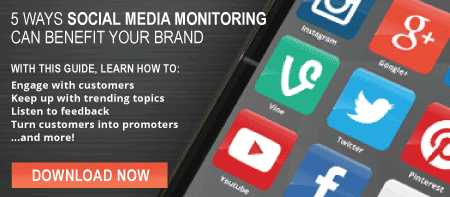
Social media is a great way to interact and communicate directly with your online customers, but without engagement and Return on Investment (ROI), you're just spinning your wheels. When used strategically, it can grow your customer base, increase visits to your website, and ultimately increase your sales. If you’re a really savvy social media user, you can do it all for free. You can start by downloading our social media planning template, here. If you're looking for an introduction on how to get started with social media before you start measuring, check out our introduction to social media marketing.
According to the 2014 Social Media Marketing Industry Report from Social Media Examiner, 92% of marketers use social media for business. And, there’s a very good reason for that.
The ultimate goal is to convert followers into leads, creating happy customers who eventually become mavens and promoters of your brand. So it’s important to make the most of all the opportunities that social media offers to help you connect and communicate with your customers.
Return on Investment (ROI)
ROI can be measured with the right social media strategy and tools. You need to dive deeper than just engagement metrics to see how your social media efforts are driving sales. A single tweet or post has ROI and, as a marketer, we can - and should - know what that is.
Social media channels are littered with campaigns and strategies aimed at driving followers from their newsfeed to a company website in hopes they will make a purchase. Common practices include:
- Click to get a coupon
- Mention us and receive a special offer
- Check-in discounts
- Contests and drawings
- Like, Share, Win, Pick up in-store promo
- Flash sales
- Gift card promotions i.e. “If your name is Ann or Mike you win a $10 gift card to our store.”
These types of campaigns are the most effective because they get social media followers to act, as opposed to sitting back, watching, and reading your posts. The more your audience participates and feels rewarded, the more likely they are to invest more than just their time on social media.
Social Media Analytics
Each social media platform offers analytics and feedback on page performance. Through this you can discover how your social media efforts are impacting customers and influencing sales.
Facebook Insights is available to page managers and provides several useful metrics. You can view real-time data about your audience, see when they’re online and determine the most optimum time to reach your followers. You can also look at each post and see which generated the most likes, comments, shares, clicks and reach.
The Analytics tab is available to administrators on LinkedIn to access metrics and information about their Company Page performance. The data is divided into three sections: Updates, Followers, and Visitors. The Updates section reports the most recent updates, the Followers section provides information about your followers, and the Visitors section tracks the visitors and viewers of your page.
Pinterest analytics allows you to track the trends and activity of your account. You can find out exactly what’s been Pinned from your website, how many people are seeing and clicking on your pins. The analytics detail which Pins get shared the most and who interacts with them.
After signing up for Twitter Ads or Analytics, you can access information on how your Tweets are performing in real time. Twitter Analytics allows you to see how many times someone clicked on links you tweeted, metrics for impressions and engagement. You can also view data about your engaged users and where they are coming from.
Google Analytics is a free web-based analytics service that provides statistics and analytical tools for Search Engine Optimization (SEO) and marketing purposes. It allows you to monitor a number of page metrics, including: traffic sources, referring sites, types of visitors, popular pages, visits, and geographical location.
Google also offers, Google Conversions, which includes Goal conversions and Ecommerce conversions. This helps you track how well your website is fulfilling your business objectives and see the value of your site traffic.
Marketing Automation Software
Marketing automation software can take you to the next level in determining which posts are reflective in your sales and customer acquisition numbers. The use of sophisticated marketing automation software can provide rich data into which platforms are actually delivering leads and clients.
Inbound Marketing systems can go even further in reporting exact ROI from social media efforts. Whether you're measuring the number of new followers in a given time period or matching individual tweets to new contacts in your inbound marketing database. Inbound marketing can show you which channels work best at converting visitors into leads.
Hubspot
Hubspot is an inbound marketing platform that helps companies attract visitors, convert leads, and close customers. The software provides very precise data for reporting ROI.
You can really dig deep into ROI reporting with the Sources Report tool. This report allows you to see exactly which social media platform is driving the most visits and whether those visitors converted into contacts and customers.
Tracking ROI is the most accurate way to report and prove the value of social media efforts. It’s important to understand how visitors find your brand and which outlets to focus on to boost or continue performance. Proving ROI is essential in all marketing efforts, and social media is an essential part of the marketing mix.
Topics: marketing






